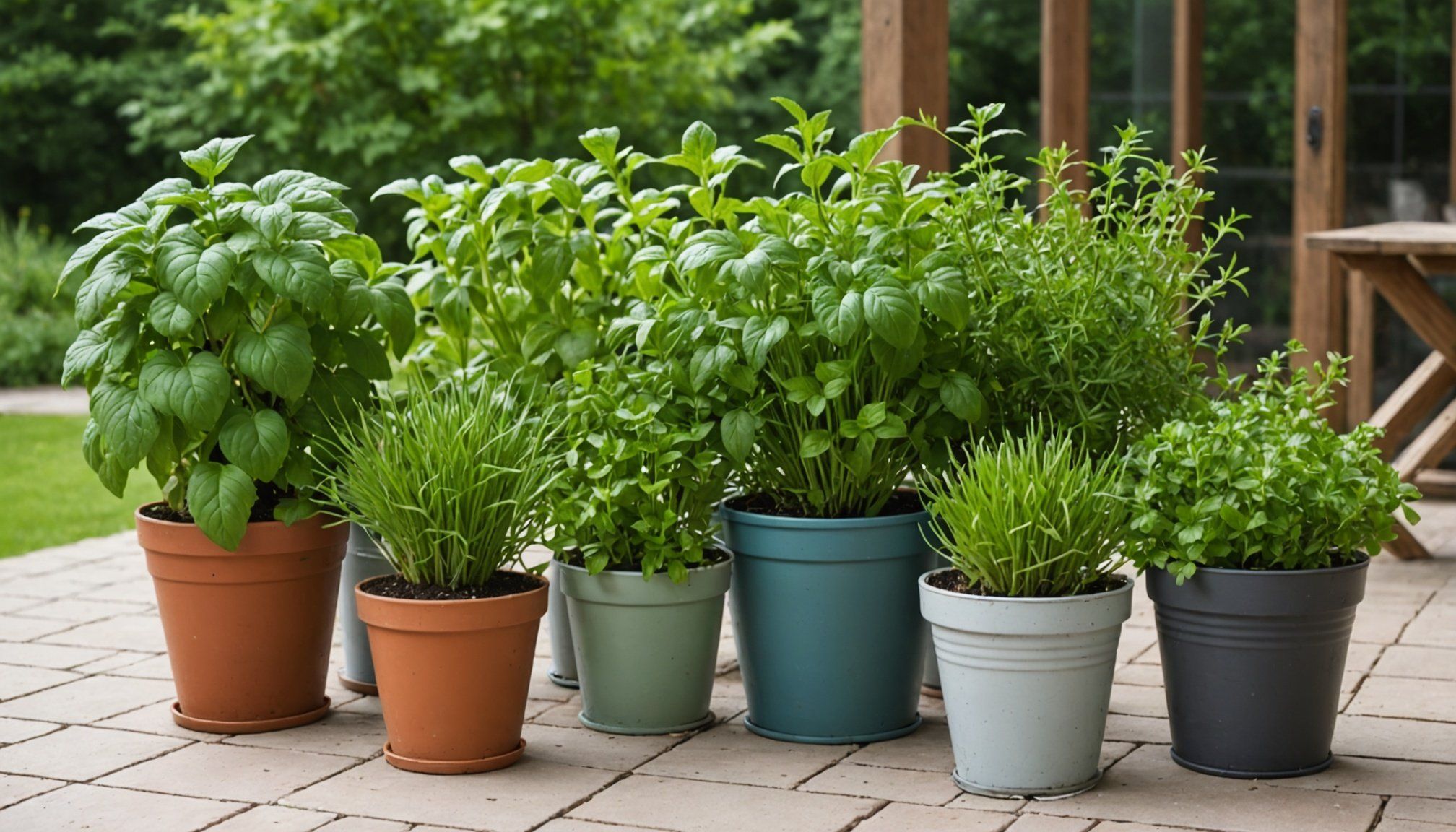Growing herbs in containers is a rewarding experience that allows you to cultivate fresh flavors right outside your door. Whether you’re an experienced gardener or just starting out, container gardening provides a versatile approach to gardening. With the right soil, pots, and attention, you can successfully grow a variety of plants in limited spaces like a patio. In this article, we will explore the best types of herbs that thrive in containers, offering you practical tips and insights to make your herb garden a success.
Choosing the Right Containers for Your Herbs
Selecting the right containers is crucial for successful herb growth. You should consider the material, size, and drainage of your pots. Popular materials for pots include terracotta, ceramic, and plastic. Terracotta pots are breathable, allowing soil to dry out, which is beneficial for herbs like thyme and mint that prefer drier conditions. Ceramic pots are aesthetically pleasing but can retain moisture more than terracotta. Plastic pots are lightweight and affordable but ensure they have good drainage holes.
Also to see : How can I design a garden that thrives in shade?
When it comes to size, choose pots that are at least 12 inches in diameter for most herbs. This will provide enough room for the roots to spread out. If you are growing multiple herbs in one container, consider larger pots, as some herbs will need more space to thrive.
Proper drainage is vital for the health of your herbs. Without it, water can accumulate in the bottom of the pot, leading to root rot. Always ensure that your containers have adequate drainage holes. You might also consider placing a layer of gravel or small stones at the bottom to facilitate better drainage. This simple step can significantly impact the growth of your plants. By choosing the right pots and ensuring proper drainage, you lay the foundation for a bountiful herb garden.
In the same genre : How can I effectively manage water usage in my garden during a drought?
Best Herbs for Container Gardening
Some herbs are particularly well-suited for container gardening due to their size, growth habits, and resilience. Mint is one of the easiest herbs to grow in pots. Its vigorous growth can be contained within a pot, preventing it from overtaking your garden. Mint thrives in full sun and requires regular watering, making it ideal for patio conditions.
Thyme is another excellent choice for container gardening. This herb loves full sun and well-draining soil. It also tolerates drought conditions, so be careful not to overwater it. You can grow different thyme varieties in a single pot, creating a lovely display of colors and flavors.
Basil is perfect for summer gardening. It loves warmth and can be easily grown in pots. Regular pinching of the leaves encourages bushier growth, ensuring a steady supply of fresh leaves for your culinary creations.
Chives are hardy and can thrive in various conditions, making them perfect for beginners. They do well in pots and require minimal care. Their mild onion flavor is a fantastic addition to many dishes.
Lastly, consider oregano and parsley. Both herbs are versatile in the kitchen and flourish in containers. Oregano prefers a sunny spot and well-drained soil, while parsley can tolerate partial shade. These herbs will not only enhance your cooking but also add a beautiful green touch to your patio.
Optimal Soil and Watering Techniques for Container Herbs
The type of soil you use plays a significant role in the health and growth of your container herbs. A high-quality potting mix that is lightweight and drains well is essential. Look for mixes labeled for container gardening, as they are often designed to retain moisture without becoming waterlogged. Adding organic matter, such as compost, can improve soil fertility and promote healthy root development.
When it comes to watering your herbs, consistency is key. Plants in containers tend to dry out faster than those in the ground. Check the top inch of the soil regularly; if it feels dry, it’s time to water. However, be cautious not to overwater. Herbs like thyme and rosemary prefer drier conditions, while basil and mint like their soil to be consistently moist.
To help maintain moisture, consider using mulch on the surface of the soil. Organic mulches, like shredded bark or straw, can help retain water and keep the roots cool. Furthermore, grouping your pots can create a microclimate that helps to retain humidity while also simplifying your watering routine.
During the growing season, fertilizing your herbs can enhance their growth. Use a balanced, water-soluble fertilizer every four to six weeks. This will ensure that your plants get the nutrients they require to flourish. With the right soil and careful watering practices, your container herbs can thrive beautifully.
Maintaining Your Container Herb Garden
Once you’ve established your container herb garden, regular maintenance is necessary to keep it thriving. Pruning is one of the most important tasks you will undertake. Regularly harvesting the leaves encourages bushier growth and prevents your herbs from becoming leggy. For herbs like basil, pinch off the flowers as they appear to encourage more leaf production.
Pest control is another consideration. Common pests, such as aphids or spider mites, can occasionally invade your herbs. Keeping your plants healthy will naturally deter many pests. If you do notice an infestation, consider using insecticidal soap or introducing beneficial insects like ladybugs to your garden. Regularly inspecting your plants for signs of distress can help you catch any issues before they escalate.
As the seasons change, you might need to adjust your gardening practices. During the hot summer months, you may need to increase your watering frequency. Conversely, as temperatures drop in the fall and winter, many herbs will become dormant and require less frequent watering.
In colder climates, some herbs may need to be brought indoors during winter months. If you do this, ensure they receive enough light, as indoor light conditions can be significantly lower than outdoors. A sunny windowsill or grow lights can help sustain their growth until warmer weather returns.
The Joy of Harvesting and Using Your Container-Grown Herbs
The ultimate reward for your efforts in container gardening is the ability to harvest fresh herbs right from your patio. There’s nothing quite like snipping a few sprigs of mint for a refreshing drink or adding a handful of thyme to a simmering sauce. Not only do fresh herbs enhance the flavor of your dishes, but they also add vibrant colors and enticing aromas.
To harvest, simply use clean scissors or garden shears to snip off the leaves or stems you need. It’s best to harvest in the morning when the essential oils are most concentrated. Don’t be afraid to trim back your herbs frequently; this encourages new growth and keeps your plants healthy.
Consider experimenting with different recipes that highlight your homegrown herbs. You could craft a mint-infused lemonade, whip up a basil pesto, or create a delightful herbal tea with a blend of your favorite leaves. The possibilities are endless!
Moreover, preserving your herbs is a great way to enjoy their flavors year-round. You can dry them, freeze them, or even make infused oils. These methods allow you to savor the benefits of your container garden long after the growing season has ended.
Growing herbs in containers on your patio is an enjoyable and fulfilling endeavor. With the right selection of plants, proper containers, and diligent care, you can create a thriving herb garden that offers fresh flavors for your culinary adventures. Remember to choose herbs that suit your climate and growing conditions, and take the time to nurture your plants. The rewards of harvesting and using your homegrown herbs are well worth the effort. So gather your pots, grab some soil, and start your journey into the world of container gardening!











